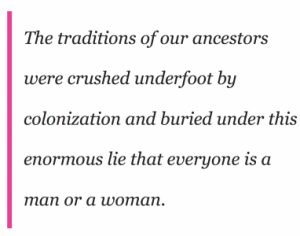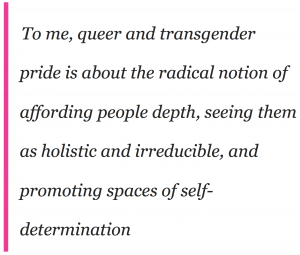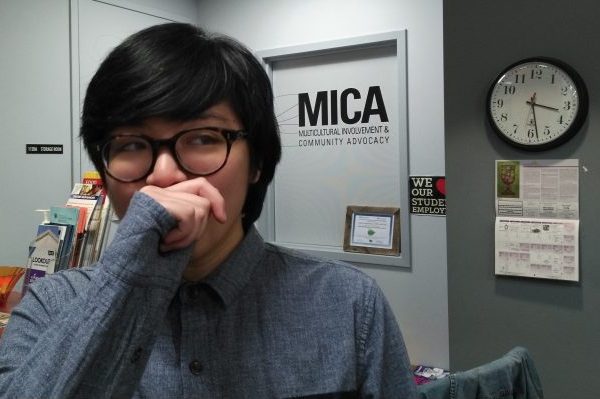It took years for me to find pride in my identities. For the majority of my life, being transgender in a society where even the most liberal and “well-intending” folks would push me to the back of the room, if they couldn’t quite get me out the door, made me feel like a nuisance. By the age of eight, I had already stopped wanting to be in the room. I spent the first two decades of my life feeling miserable, delusional and unreasonable.
A world that pretends that there are only two genders, that can be assigned to only two kinds of bodies, and that the two genders must be performed in certain ways, or the actors are perverse or lesser – this world is abusive towards everyone, not just transgender people. Dean Spade describes this heterocissexism as “a diabolically rigid gender system that screws over everyone’s ability to fully inhabit their lives.”
I realized cis-sexism was abusive when, after a lifetime of compliance with arbitrary rules and gender gaslighting resulting in self-inflicted absolute isolation, my attempts to just be myself, by myself, affecting no one and drawing no attention to my transgenderism were still seen as demanding and somehow oppressive to people who had never experienced even a minute of my lifelong struggle of justifying my continued existence as a person who could not identify with my gender assigned at birth.
I was horrible at being a girl, and I was never taught how “to be a boy.” No one had ever taught me about transgenderism, so the only language I had for my feelings was “being a boy in a past life” – and that made me fantasize about suicide in the hopes of being a boy in the next life.
Being queer often means coming into the world alone. It also often means being up Transhit-creek without a paddle.
Our existences are swept under the rug and our histories aren’t taught in schools – and if they are, queer women of color are mysteriously absent from their front line positions. Basic information like safe sex practices are withheld from us, and politicians demand that we only use the restroom in our own home – as if queer people don’t make up a large percentage of homeless populations in the United States, and as if they’d willingly go eight to ten hours without relief every day.
Our relationships are seen as shadowy imitations of true companionship and we’re denied several of our rights unless we assimilate to the heterosexual institution of marriage.
The traditions of our ancestors were crushed underfoot by colonization and buried under this enormous lie that everyone is a man or a woman, and that only a man and a woman can be together.
The first time I had actually shed tears over my heritage as a queer transgender person was in 2015, reading this sentence in The Advocate: “Dearest Queer Person; Chances are you don’t even know that you are holy or royal or magic, but you are. You are part of an adoptive family going back through every generation of human existence.”
My generation doesn’t even know that thousands of queer elders who could have mentored and empowered us are missing from our tables because of the malicious negligence of the United States government. We’re often lead to believe that we exist in a vacuum, disconnected from a history or a community
 We have a hard time conceptualizing queer adulthood, and are discouraged from making connections with older queer people because of pedophilic stereotypes. We think our lives are quick, miserable bursts of color and sound that snuff out in our mid-twenties because the only gay people on television are miserable or dead. We are gaslighted into thinking racism, sexism, homophobia, and transphobia are somehow weaker forces than they were before, when they’re not. We think that only white people can be queer.
We have a hard time conceptualizing queer adulthood, and are discouraged from making connections with older queer people because of pedophilic stereotypes. We think our lives are quick, miserable bursts of color and sound that snuff out in our mid-twenties because the only gay people on television are miserable or dead. We are gaslighted into thinking racism, sexism, homophobia, and transphobia are somehow weaker forces than they were before, when they’re not. We think that only white people can be queer.
When I think of being queer and transgender, I think of resilience. I think pride is in many ways connected to resilience. I think of survival, and I think of Stonewall because “THE FIRST GAY PRIDE WAS A RIOT.” I think about how 99.7% of the United States can justify lifelong abuse against the other 0.3% because one million people seem insignificant when you call them “point-three-percent,” and how their concept of revolutionary trans allyship is exclusively asking for pronouns – and then misgendering us anyway.
One million people is too few to bother challenging cis-sexism, even though all narratives, unless freely chosen, are toxic and oppressive to all people. No model will ever account for all human experiences, and abolishing heteronormativity and cis-sexism won’t throw society into chaos – and by the way?
Cis-sexism is just a fluffy way of saying transphobia. Heteronormativity and cis-sexism aren’t diet homophobia or transphobia. Forcing these narratives on people is a violent removal of agency and denial of self-determination. Just surviving this crap and recognizing it for what it is – crap – is enough for me to be proud of queer and transgender folx.
To me, queer and transgender pride is about the radical notion of affording people depth, seeing them as holistic and irreducible, and promoting spaces of self-determination. It’s inherently about resistance, and defiant vulnerability, and the dissolution of dichotomies. It’s about shedding things we’ve deified for ridiculous, arbitrary reasons, and refusing cognitive shortcuts when we try to understand human experiences. It’s about overcoming shame about being in-between or upside-down, and about trying to make things easier for those who come after us.
Max Balagtas-Badoy is the LGBTQ Student Involvement Community Organizing Student Intern at the Office of Multicultural Involvement & Community Advocacy at the University of Maryland, where he is psychology major.


